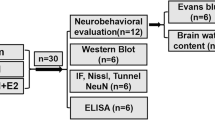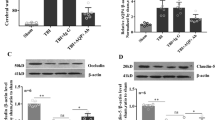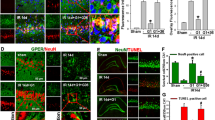Abstract
This study aimed to investigate the effects of G1-activated G protein-coupled estrogen receptor 1 (GPER1) on neurological impairments and neuroinflammation in traumatic brain injury (TBI) mice. The controlled cortical impingement (CCI) method was used to establish the TBI model. The mice were subjected to ovariectomy (OVX) for two weeks prior to modeling. GPER1 agonist G1 was administered by intracerebroventricular injection. Brain tissue water content was detected by wet/dry method, and blood-brain barrier damage was detected by Evans blue extravasation. The neurological impairments in mice were evaluated by open field test, Y-maze test, nest-building test, object location memory test and novel object recognition test. Ionized calcium-binding adapter molecule 1 (Iba1) staining was used to indicate the activation of microglia. Expression of M1/M2-type microglia markers and inflammatory factors were evaluated by ELISA and qRT-PCR. The G1 administration significantly reduced cerebral edema and Evans blue extravasation at injury ipsilateral cortex and basal ganglia in TBI mice. Activation of GPER1 by G1 improved the anxiety behavior and the cognitive dysfunction of mice induced by TBI. G1 administration significantly decreased Iba1-positive staining cells and the mRNA levels of CD86, macrophage cationic peptide 1 (Mcp-1), nitric oxide synthase 2 (Nos2), interleukin 1 beta (IL-1β), and macrophage inflammatory protein-2 (MIP-2), while increased the mRNA levels of interleukin 10 (IL-10), arginase1 (Arg-1) and CD206. Activation of GPER1 through G1 administration has the potential to ameliorate cognitive dysfunction induced by TBI in mice. It may also inhibit the activation of M1 microglia in cortical tissue resulting from TBI, while promoting the activation of M2 microglia and contributing to the regulation of inflammatory responses.






Similar content being viewed by others
Data Availability
The raw data supporting the conclusions of this article will be made available on request to the corresponding author by email, as requested by our department.
References
Vella MA, Crandall ML, Patel MB (2017) Acute management of traumatic brain injury. Surg Clin North Am 97(5):1015–1030. https://doi.org/10.1016/j.suc.2017.06.003
Galgano M, Toshkezi G, Qiu X, Russell T, Chin L, Zhao LR (2017) Traumatic brain injury: current treatment strategies and future endeavors. Cell Transpl 26(7):1118–1130. https://doi.org/10.1177/0963689717714102
Khellaf A, Khan DZ, Helmy A (2019) Recent advances in traumatic brain injury. J Neurol 266(11):2878–2889. https://doi.org/10.1007/s00415-019-09541-4
Capizzi A, Woo J, Verduzco-Gutierrez M (2020) Traumatic brain injury: an overview of epidemiology, pathophysiology, and medical management. Med Clin North Am 104(2):213–238. https://doi.org/10.1016/j.mcna.2019.11.001
Wang KK, Yang Z, Zhu T, Shi Y, Rubenstein R, Tyndall JA, Manley GT (2018) An update on diagnostic and prognostic biomarkers for traumatic brain injury. Expert Rev Mol Diagn 18(2):165–180. https://doi.org/10.1080/14737159.2018.1428089
McGinn MJ, Povlishock JT (2016) Pathophysiology of traumatic brain injury. Neurosurg Clin N Am 27(4):397–407. https://doi.org/10.1016/j.nec.2016.06.002
Witcher KG, Bray CE, Chunchai T, Zhao F, O’Neil SM, Gordillo AJ, Campbell WA, McKim DB, Liu X, Dziabis JE, Quan N, Eiferman DS, Fischer AJ, Kokiko-Cochran ON, Askwith C, Godbout JP (2021) Traumatic brain injury causes chronic cortical inflammation and neuronal dysfunction mediated by microglia. J Neurosci 41(7):1597–1616. https://doi.org/10.1523/JNEUROSCI.2469-20.2020
Karve IP, Taylor JM, Crack PJ (2016) The contribution of astrocytes and microglia to traumatic brain injury. Br J Pharmacol 173(4):692–702. https://doi.org/10.1111/bph.13125
Wu H, Zheng J, Xu S, Fang Y, Wu Y, Zeng J, Shao A, Shi L, Lu J, Mei S, Wang X, Guo X, Wang Y, Zhao Z, Zhang J (2021) Mer regulates microglial/macrophage M1/M2 polarization and alleviates neuroinflammation following traumatic brain injury. J Neuroinflammation 18(1):2. https://doi.org/10.1186/s12974-020-02041-7
Honjoh K, Nakajima H, Hirai T, Watanabe S, Matsumine A (2019) Relationship of inflammatory cytokines from M1-Type microglia/macrophages at the injured site and lumbar enlargement with neuropathic pain after spinal cord injury in the CCL21 knockout (plt) mouse. Front Cell Neurosci 13:525. https://doi.org/10.3389/fncel.2019.00525
Yang J, Zhao Y, Zhang L, Fan H, Qi C, Zhang K, Liu X, Fei L, Chen S, Wang M, Kuang F, Wang Y, Wu S (2018) RIPK3/MLKL-Mediated neuronal necroptosis modulates the M1/M2 polarization of microglia/macrophages in the ischemic cortex. Cereb Cortex 28(7):2622–2635. https://doi.org/10.1093/cercor/bhy089
Prossnitz ER, Barton M (2011) The G-protein-coupled estrogen receptor GPER in health and disease. Nat Rev Endocrinol 7(12):715–726. https://doi.org/10.1038/nrendo.2011.122
Brailoiu E, Dun SL, Brailoiu GC, Mizuo K, Sklar LA, Oprea TI, Prossnitz ER, Dun NJ (2007) Distribution and characterization of estrogen receptor G protein-coupled receptor 30 in the rat central nervous system. J Endocrinol 193(2):311–321. https://doi.org/10.1677/JOE-07-0017
Hazell GG, Yao ST, Roper JA, Prossnitz ER, O’Carroll AM, Lolait SJ (2009) Localisation of GPR30, a novel G protein-coupled oestrogen receptor, suggests multiple functions in rodent brain and peripheral tissues. J Endocrinol 202(2):223–236. https://doi.org/10.1677/JOE-09-0066
Tang H, Zhang Q, Yang L, Dong Y, Khan M, Yang F, Brann DW, Wang R (2014) GPR30 mediates estrogen rapid signaling and neuroprotection. Mol Cell Endocrinol 387(1–2):52–58. https://doi.org/10.1016/j.mce.2014.01.024
Day NL, Floyd CL, D’Alessandro TL, Hubbard WJ, Chaudry IH (2013) 17beta-estradiol confers protection after traumatic brain injury in the rat and involves activation of G protein-coupled estrogen receptor 1. J Neurotrauma 30(17):1531–1541. https://doi.org/10.1089/neu.2013.2854
Lu D, Qu Y, Shi F, Feng D, Tao K, Gao G, He S, Zhao T (2016) Activation of G protein-coupled estrogen receptor 1 (GPER-1) ameliorates blood-brain barrier permeability after global cerebral ischemia in ovariectomized rats. Biochem Biophys Res Commun 477(2):209–214. https://doi.org/10.1016/j.bbrc.2016.06.044
Pu H, Ma C, Zhao Y, Wang Y, Zhang W, Miao W, Yu F, Hu X, Shi Y, Leak RK, Hitchens TK, Dixon CE, Bennett MV, Chen J (2021) Intranasal delivery of interleukin-4 attenuates chronic cognitive deficits via beneficial microglial responses in experimental traumatic brain injury. J Cereb Blood Flow Metab 41(11):2870–2886. https://doi.org/10.1177/0271678X211028680
Chen P, Wang C, Ren YN, Ye ZJ, Jiang C, Wu ZB (2021) Alterations in the gut microbiota and metabolite profiles in the context of neuropathic pain. Mol Brain 14(1):50. https://doi.org/10.1186/s13041-021-00765-y
Pan MX, Tang JC, Liu R, Feng YG, Wan Q (2018) Effects of estrogen receptor GPR30 agonist G1 on neuronal apoptosis and microglia polarization in traumatic brain injury rats. Chin J Traumatol 21(4):224–228. https://doi.org/10.1016/j.cjtee.2018.04.003
Kozler P, Maresova D, Pokorny J (2022) Determination of brain water content by dry/wet weight measurement for the detection of experimental brain edema. Physiol Res 71(S2):S277–S283. https://doi.org/10.33549/physiolres.934996
Xu Y, He Q, Wang M, Wang X, Gong F, Bai L, Zhang J, Wang W (2019) Quantifying blood-brain-barrier leakage using a combination of evans blue and high molecular weight FITC-Dextran. J Neurosci Methods 325:108349. https://doi.org/10.1016/j.jneumeth.2019.108349
Hayashi K, Hasegawa Y, Takemoto Y, Cao C, Mukasa A, Kim-Mitsuyama S (2020) Enhanced oxidative stress contributes to worse prognosis and delayed neurofunctional recovery after striatal intracerebral hemorrhage in 5XFAD mice. Eur J Neurosci 51(8):1806–1814. https://doi.org/10.1111/ejn.14596
Yoshizaki K, Asai M, Hara T (2020) High-fat diet enhances working memory in the Y-maze test in male C57BL/6J mice with less anxiety in the elevated plus maze test. Nutrients 12(7). https://doi.org/10.3390/nu12072036
Yuan D, Liu C, Wu J, Hu B (2018) Nest-building activity as a reproducible and long-term stroke deficit test in a mouse model of stroke. Brain Behav 8(6):e00993. https://doi.org/10.1002/brb3.993
Weiss C, Bertolino N, Procissi D, Aleppo G, Smith QC, Viola KL, Bartley SC, Klein WL, Disterhoft JF (2022) Diet-induced Alzheimer’s-like syndrome in the rabbit. Alzheimers Dement (N Y) 8(1):e12241. https://doi.org/10.1002/trc2.12241
Antunes M, Biala G (2012) The novel object recognition memory: neurobiology, test procedure, and its modifications. Cogn Process 13(2):93–110. https://doi.org/10.1007/s10339-011-0430-z
Hendrickx DAE, van Eden CG, Schuurman KG, Hamann J, Huitinga I (2017) Staining of HLA-DR, Iba1 and CD68 in human microglia reveals partially overlapping expression depending on cellular morphology and pathology. J Neuroimmunol 309:12–22. https://doi.org/10.1016/j.jneuroim.2017.04.007
Robinson CP (2021) Moderate and severe traumatic brain injury. Continuum (Minneap Minn) 27(5):1278–1300. https://doi.org/10.1212/CON.0000000000001036
Leikin JB (2019) Traumatic brain injury. Dis Mon 65(10):100857. https://doi.org/10.1016/j.disamonth.2019.02.010
Baxendale S, Heaney D, Rugg-Gunn F, Friedland D (2019) Neuropsychological outcomes following traumatic brain injury. Pract Neurol 19(6):476–482. https://doi.org/10.1136/practneurol-2018-002113
Appelros P, Stegmayr B, Terent A (2009) Sex differences in stroke epidemiology: a systematic review. Stroke 40(4):1082–1090. https://doi.org/10.1161/STROKEAHA.108.540781
Santoro A, Mele E, Marino M, Viggiano A, Nori SL, Meccariello R (2021) The complex interplay between endocannabinoid system and the estrogen system in central nervous system and periphery. Int J Mol Sci 22(2). https://doi.org/10.3390/ijms22020972
McEwen BS, Alves SE (1999) Estrogen actions in the central nervous system. Endocr Rev 20(3):279–307. https://doi.org/10.1210/edrv.20.3.0365
Bruce-Keller AJ, Keeling JL, Keller JN, Huang FF, Camondola S, Mattson MP (2000) Antiinflammatory effects of estrogen on microglial activation. Endocrinology 141(10):3646–3656. https://doi.org/10.1210/endo.141.10.7693
Dimayuga FO, Reed JL, Carnero GA, Wang C, Dimayuga ER, Dimayuga VM, Perger A, Wilson ME, Keller JN, Bruce-Keller AJ (2005) Estrogen and brain inflammation: effects on microglial expression of MHC, costimulatory molecules and cytokines. J Neuroimmunol 161(1–2):123–136. https://doi.org/10.1016/j.jneuroim.2004.12.016
Zhao TZ, Ding Q, Hu J, He SM, Shi F, Ma LT (2016) GPER expressed on microglia mediates the anti-inflammatory effect of estradiol in ischemic stroke. Brain Behav 6(4):e00449. https://doi.org/10.1002/brb3.449
Guan J, Yang B, Fan Y, Zhang J (2017) GPER Agonist G1 attenuates neuroinflammation and dopaminergic neurodegeneration in Parkinson disease. Neuroimmunomodulation 24(1):60–66. https://doi.org/10.1159/000478908
Broughton BR, Brait VH, Kim HA, Lee S, Chu HX, Gardiner-Mann CV, Guida E, Evans MA, Miller AA, Arumugam TV, Drummond GR, Sobey CG (2014) Sex-dependent effects of G protein-coupled estrogen receptor activity on outcome after ischemic stroke. Stroke 45(3):835–841. https://doi.org/10.1161/STROKEAHA.113.001499
Wu Y, Feng D, Lin J, Qu Y, He S, Wang Y, Gao G, Zhao T (2018) Downregulation of G–protein–coupled receptor 30 in the hippocampus attenuates the neuroprotection of estrogen in the critical period hypothesis. Mol Med Rep 17(4):5716–5725. https://doi.org/10.3892/mmr.2018.8618
Kastenberger I, Schwarzer C (2014) GPER1 (GPR30) knockout mice display reduced anxiety and altered stress response in a sex and paradigm dependent manner. Horm Behav 66(4):628–636. https://doi.org/10.1016/j.yhbeh.2014.09.001
Kajta M, Wnuk A, Rzemieniec J, Litwa E, Lason W, Zelek-Molik A, Nalepa I, Rogoz Z, Grochowalski A, Wojtowicz AK (2017) Depressive-like effect of prenatal exposure to DDT involves global DNA hypomethylation and impairment of GPER1/ESR1 protein levels but not ESR2 and AHR/ARNT signaling. J Steroid Biochem Mol Biol 171:94–109. https://doi.org/10.1016/j.jsbmb.2017.03.001
Dovey JL, Vasudevan N (2020) Does GPER1 play a role in sexual dimorphism? Front Endocrinol (Lausanne) 11:595895. https://doi.org/10.3389/fendo.2020.595895
Sharma G, Prossnitz ER (2017) G-Protein-coupled estrogen receptor (GPER) and sex-specific metabolic homeostasis. Adv Exp Med Biol 1043:427–453. https://doi.org/10.1007/978-3-319-70178-3_20
Blaya MO, Raval AP, Bramlett HM (2022) Traumatic brain injury in women across lifespan. Neurobiol Dis 164:105613. https://doi.org/10.1016/j.nbd.2022.105613
Caplan HW, Cox CS, Bedi SS (2017) Do microglia play a role in sex differences in TBI? J Neurosci Res 95(1–2):509–517. https://doi.org/10.1002/jnr.23854
Frost RB, Farrer TJ, Primosch M, Hedges DW (2013) Prevalence of traumatic brain injury in the general adult population: a meta-analysis. Neuroepidemiology 40(3):154–159. https://doi.org/10.1159/000343275
Li Y, Yang YY, Ren JL, Xu F, Chen FM, Li A (2017) Exosomes secreted by stem cells from human exfoliated deciduous teeth contribute to functional recovery after traumatic brain injury by shifting microglia M1/M2 polarization in rats. Stem Cell Res Ther 8(1):198. https://doi.org/10.1186/s13287-017-0648-5
Yao X, Liu S, Ding W, Yue P, Jiang Q, Zhao M, Hu F, Zhang H (2017) TLR4 signal ablation attenuated neurological deficits by regulating microglial M1/M2 phenotype after traumatic brain injury in mice. J Neuroimmunol 310:38–45. https://doi.org/10.1016/j.jneuroim.2017.06.006
Gao T, Chen Z, Chen H, Yuan H, Wang Y, Peng X, Wei C, Yang J, Xu C (2018) Inhibition of HMGB1 mediates neuroprotection of traumatic brain injury by modulating the microglia/macrophage polarization. Biochem Biophys Res Commun 497(1):430–436. https://doi.org/10.1016/j.bbrc.2018.02.102
Jiang Z, Tang M (2020) Inflammatory events drive neural stem cell migration by elevating stromal-derived factor 1 alpha. STEMedicine 1(3):e59. https://doi.org/10.37175/stemedicine.v1i3.59
Zheng Y, Wu M, Gao T, Meng L, Ding X, Meng Y, Jiao Y, Luo P, He Z, Sun T, Zhang G, Shi X, Rong W (2020) GPER-deficient rats exhibit lower serum corticosterone level and increased anxiety-like behavior. Neural Plast 2020:8866187. https://doi.org/10.1155/2020/8866187
Bian C, Zhu H, Zhao Y, Cai W, Zhang J (2014) Intriguing roles of hippocampus-synthesized 17beta-estradiol in the modulation of hippocampal synaptic plasticity. J Mol Neurosci 54(2):271–281. https://doi.org/10.1007/s12031-014-0285-8
Hawley WR, Grissom EM, Moody NM, Dohanich GP, Vasudevan N (2014) Activation of G-protein-coupled receptor 30 is sufficient to enhance spatial recognition memory in ovariectomized rats. Behav Brain Res 262:68–73. https://doi.org/10.1016/j.bbr.2014.01.006
Wang ZF, Pan ZY, Xu CS, Li ZQ (2017) Activation of G-protein coupled estrogen receptor 1 improves early-onset cognitive impairment via PI3K/Akt pathway in rats with traumatic brain injury. Biochem Biophys Res Commun 482(4):948–953. https://doi.org/10.1016/j.bbrc.2016.11.138
Ervin KS, Mulvale E, Gallagher N, Roussel V, Choleris E (2015) Activation of the G protein-coupled estrogen receptor, but not estrogen receptor alpha or beta, rapidly enhances social learning. Psychoneuroendocrinology 58:51–66. https://doi.org/10.1016/j.psyneuen.2015.04.002
Gabor C, Lymer J, Phan A, Choleris E (2015) Rapid effects of the G-protein coupled oestrogen receptor (GPER) on learning and dorsal hippocampus dendritic spines in female mice. Physiol Behav 149:53–60. https://doi.org/10.1016/j.physbeh.2015.05.017
Pisani SL, Neese SL, Doerge DR, Helferich WG, Schantz SL, Korol DL (2012) Acute genistein treatment mimics the effects of estradiol by enhancing place learning and impairing response learning in young adult female rats. Horm Behav 62(4):491–499. https://doi.org/10.1016/j.yhbeh.2012.08.006
Hadjimarkou MM, Vasudevan N (2018) GPER1/GPR30 in the brain: crosstalk with classical estrogen receptors and implications for behavior. J Steroid Biochem Mol Biol 176:57–64. https://doi.org/10.1016/j.jsbmb.2017.04.012
Waters EM, Thompson LI, Patel P, Gonzales AD, Ye HZ, Filardo EJ, Clegg DJ, Gorecka J, Akama KT, McEwen BS, Milner TA (2015) G-protein-coupled estrogen receptor 1 is anatomically positioned to modulate synaptic plasticity in the mouse hippocampus. J Neurosci 35(6):2384–2397. https://doi.org/10.1523/JNEUROSCI.1298-14.2015
Zuo D, Wang F, Rong W, Wen Y, Sun K, Zhao X, Ren X, He Z, Ding N, Ma L, Xu F (2020) The novel estrogen receptor GPER1 decreases epilepsy severity and susceptivity in the hippocampus after status epilepticus. Neurosci Lett 728:134978. https://doi.org/10.1016/j.neulet.2020.134978
Acknowledgements
None.
Funding
This work was supported by the National Natural Science Foundation of China (no. 81971153, no. 81200902).
Author information
Authors and Affiliations
Contributions
Yafei Xue: Data curation, Conceptualization, Methodology, Writing- Original draft preparation, Investigation, Methodology, Writing- Original draft preparation, Writing- Reviewing and Editing. Yunze Zhang: Data curation, Validation, Writing- Original draft preparation. Yingxi Wu: Data curation, Writing- Original draft preparation. Tianzhi Zhao: Conceptualization, Writing- Original draft preparation, Supervision, Writing- Reviewing and Editing.
Corresponding authors
Ethics declarations
Consent to Participate
Not applicable.
Consent for Publication
Current study is available from the corresponding author on reasonable request.
Disclosure of Potential Conflicts of Interest
The authors declare that there is no conflict of interests.
Research Involving Human Participants and/or Animals
The animal study was approved by the ethics committee of Tangdu Hospital, Fourth Military Medical University. This study was performed in strict accordance with the NIH guidelines for the care and use of laboratory animals (NIH Publication No. 85 − 23 Rev. 1985).
Informed Consent
Not applicable.
Additional information
Publisher’s Note
Springer Nature remains neutral with regard to jurisdictional claims in published maps and institutional affiliations.
Electronic Supplementary Material
Below is the link to the electronic supplementary material.
Rights and permissions
Springer Nature or its licensor (e.g. a society or other partner) holds exclusive rights to this article under a publishing agreement with the author(s) or other rightsholder(s); author self-archiving of the accepted manuscript version of this article is solely governed by the terms of such publishing agreement and applicable law.
About this article
Cite this article
Xue, Y., Zhang, Y., Wu, Y. et al. Activation of GPER-1 Attenuates Traumatic Brain Injury-Induced Neurological Impairments in Mice. Mol Neurobiol (2024). https://doi.org/10.1007/s12035-024-03919-w
Received:
Accepted:
Published:
DOI: https://doi.org/10.1007/s12035-024-03919-w




